

Space and Planet Photoshop Tutorials To Create Amazing Space Scenes. There a lot of space tutorials out there some are better than others, I have managed to try and select a few of what I think can allow you to get great effects that look like they belong and don’t look completely Photoshopped.
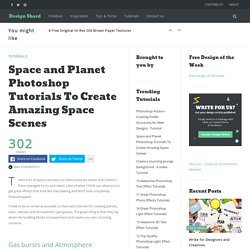
I tried to be as varied as possible so there are tutorials for creating planets, stars, nebulas and atmospheric type gasses. The great thing is that they lay down the building blocks to experiment and create you own stunning universe. Gas bursts and Atmosphere This tutorial shows you how to create some great gas explosions coming from the planets atmosphere with some pretty simple tools, yet looks stunning Realistic Star fields Create realistic star fields, the trick with this one is to be totally random and keep building up your layers the end result will speak for it self, with an image that looks like its evolving.
Simple Star fields Create simple yet affective star fields in 8 easy steps. Realistic Galaxy Realistic Space Nebula Space Nebula. NormalMap. What is a Normal Map?

A Normal Map is usually used to fake high-res geometry detail when it's mapped onto a low-res mesh. The pixels of the normal map each store a normal, a vector that describes the surface slope of the original high-res mesh at that point. UV Sets in Maya by Andrew Klein. Linking to UV Sets with the UV Relationship Editor The purpose of this demo is to provide an educational framework for two common uses of the UV-Centric, UV linking, Relationship Editor.
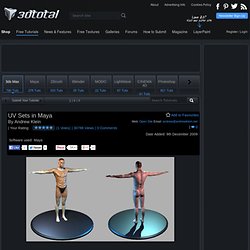
First of all, a little context: Why would we want to go through this trouble of establishing UV sets? What are some of the common uses? And, what is a UV set? Well, in general, UV sets are a function inside Maya which allow for the easy selection of UVs. Ben Cloward - Character Animator. Four-Way Tiling. October 2010 (this is derived from a post I made on the Spiral Graphics forum) Four-way tiling is a texturing trick that allows a texture to be rotated 90° and/or flipped on adjacent polygons, but still tile with itself.
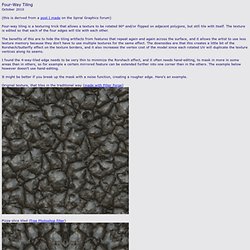
The texture is edited so that each of the four edges will tile with each other. The benefits of this are to hide the tiling artifacts from features that repeat again and again across the surface, and it allows the artist to use less texture memory because they don't have to use multiple textures for the same effect. The downsides are that this creates a little bit of the Rorshach/butterfly effect on the texture borders, and it also increases the vertex cost of the model since each rotated UV will duplicate the texture vertices along its seams. Multi-Photo Panoramas in 3ds Max. December 2006 The end result.
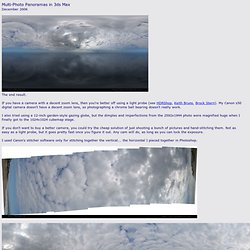
If you have a camera with a decent zoom lens, then you're better off using a light probe (see HDRShop, Keith Bruns, Brock Stern). My Canon s50 digital camera doesn't have a decent zoom lens, so photographing a chrome ball bearing doesn't really work. I also tried using a 12-inch garden-style gazing globe, but the dimples and imperfections from the 2592x1944 photo were magnified huge when I finally got to the 1024x1024 cubemap stage.
If you don't want to buy a better camera, you could try the cheap solution of just shooting a bunch of pictures and hand-stitching them. I used Canon's stitcher software only for stitching together the vertical... the horizontal I pieced together in Photoshop. Game Artist - Ambient Occlusion in Maya. AMBIENT OCCLUSION IN MAYA8 and PHOTOSHOP This tutorial covers the basics of how to setup and bake ambient occlusion maps in Maya8.

The process is similar for previous versions of Maya only the menu names will be different. nDo 2 complete run-down. Limestone Pavement Conservation Geology Picture Gallery. Tile Texture. MATERIALS. Tutorials by Philip Klevestav < Back to Tutorials Index page On this page I have tried to create a few step by step tutorials including a lot of hints and tricks I use when creating such materials.
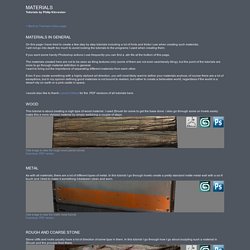
I will not go into depth too much to avoid locking the tutorials to the programs I used when creating them. If you want some handy Photoshop actions I use frequently you can find a .atn file at the bottom of this page. The materials created here are not to be seen as tiling textures only (some of them are not even seamlessly tiling), but the point of the tutorials are more to go through material definition in general. Even if you create something with a highly stylized art direction, you will most likely want to define your materials anyhow, of course there are a lot of exceptions, but in my opinion defining good materials is not bound to realism, but rather to create a believable world, regardless if the world is a desert city on earth or a pink castle in space. » Download: PT Actions.
Tutorial: Hard Surface Texture Painting. The Top Ten Tips of Texturing. One way to create dirt has already been covered, and that's photo overlays.

Those are great for general wear and tear on your texture. If you want small specific details, you'll need to use other techniques. Below are a two techniques I frequently use, one for dust and dirt, and one for rust. Dust and dirt can be done very quickly with a solid brownish layer and a layer mask. Simply put the dirt layer at the top of your stack, and paint with a low opacity and flow. Rust is a bit more tricky. I used to handpaint rust, but it always had a bit of a cartoony look, and I was never able to get crispy rust that looks convincing and real. That was until DennisPls shared his technique with me, which I've been using ever since.
Good damage placement only requires one thing: logical thinking. That can be chipped paint, scratches, rust, etc. There is a sure chance that you'll find dust and dirt in such an area. Texture Creation using nDo2. About : Creating textures using photosources for Diffuse, and nDo2 for the Normal map.

Target Audience : Photoshop and nDo2 users – Intermediate Platform : Photoshop/nDo2 Latest Update :October 2011 Introduction. The tree - Creating surface textures tip. By default Asset Tracking will not show the status for files on network drives.

Read More >> Subscribe to RSS feed The UV editing improvements in Maya 2015 are the most substantial that we seen in many years. In part 1 of my Maya 2015 UV editing overview I'll cover the new Unfold 3D algorithm along with the companion BonusTools called AutoUnwrapUVs. I'll also show how the related Checker and Distortion Shading options can be used to evaluate the results. Read More >>